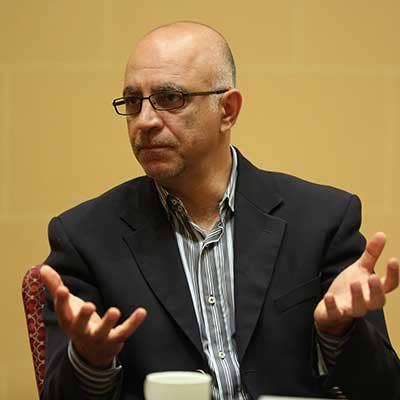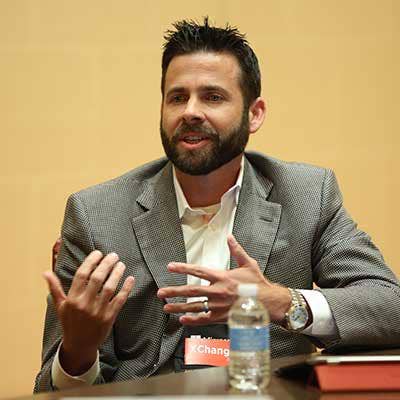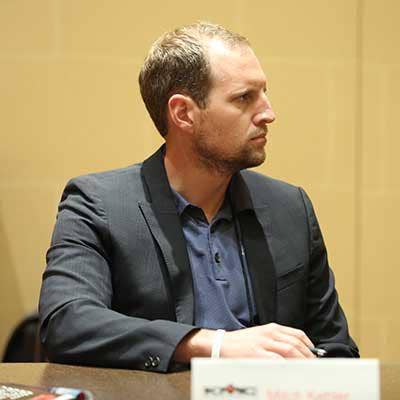Where 4 Vendors See Big IoT Opportunities For Channel Partners

IoT Channel Opportunities
The Internet of Things is no longer hype – it's here, and channel partners are positioning themselves to make the leap into IoT.
During an exclusive roundtable with four vendors – Cisco, ForeScout, Intel and KMC Controls, CRN learned how vendors specializing in components, networking, security and building automation technology are teaming with their channel partners to tackle IoT.
Following are excerpts of the conversation with four executives – Cisco Vice President of IoT Solutions Tony Shakib, ForeScout Senior Vice President Rob Greer, Intel Managing Director Steen Graham, and KMC Controls Vice President of Sales Mitch Kehler –on how they are working with channel partners to enable and deploy Internet of Things solutions across various vertical markets.

CRN: How is your company approaching the Internet of Things?
Intel's Steen Graham
From an Intel point of view, we actually are absolutely focused on distinct and separate verticals. We've got business units, or practices, set up from a vertical point of view. The one thing that I think is critical for the channel to scale and really monetize these opportunities is to go beyond the vertical and target the use case and the business outcome. That's where I see a lot of the opportunities. Many of the business problems are multi-vertical business problems.
When you're trying to solve a business problem, you have to go to a smart solution all the way to a retail point of sales solution and have those data sets combined to generate that end-user outcome. You've got to have domain expertise from the vertical, but I'd say go beyond that to the business problem you're trying to solve.

Cisco's Tony Shakib
Our approach is to build horizontally, but go to market vertically. The customers only understand things from their vertical. They really are not that technology-savvy. IoT is not about technology, and it's not so much about the internet, it's more about the things that the different customers own. Our approach has been to try and build horizontal platforms as much as possible. Where I do agree is that almost 70 percent of the things that you're trying to solve are common. You're doing location-based services, you're doing asset tracking, you're trying to do asset optimization and then you've just got to re-skin it for the different verticals and then add the level of uniqueness that they need to be successful.

ForeScout's Rob Greer
ForeScout is really focused on cybersecurity. Our platform is agentless by nature. The idea is you see what's connected to your environment, whether its wireless, wired, or across VPN. And the first step that a partner needs to understand is what's connecting to the environment. You then look at alternative options for your customer around IoT, and IoT is not just about things you know about, it's also about things that you don't know about. If I were a partner -- in my past I was -- I always am looking for adjacencies to expand my portfolio and my services. One way to do that is simply by taking the move from just IT to OT (operational technology), and it could be as simple as taking over what traditionally has been done by your audio-video guy.

KMC Controls' Mitch Kehler
We have our own software platform that can store all that data in a SQL database and I guess traditionally every building automation company has siloed their information as much as they can for various reasons that everybody always has. The IOT play is to get all that data into a common structure that everybody can begin to use, and we're basically creating an ecosystem.
Really we're the first company to embrace it. Well call it IoT as an open platform, but what we're really enabling the new companies to do is put a platform in that's expandable or upgradable in the future, more so than in the past. An open platform that more people can develop on, create more tools to use, by being open. Also by utilizing our cloud service, which hasn't been well embraced by the building automation space in the past.

CRN: What role is the channel playing in your IoT strategy?
KMC's Mitch Kehler
From KMC or a building automation perspective, [IoT is] very new, it's very undeveloped because we've traditionally dealt with an [OT] channel that knows how the building operates, knows the systems, and they're trying to apply this to that market.
The IT side is controlling the network that we're eventually trying to build onto or grow now. Everybody's vying for that space, I think the IT companies are positioned at a good place because the network side of it is where all the data is going, I'm trying to get that out now, but at the same time you still need that operational expertise or knowledge of the facility because in a lot of cases, what we're trying to do is bring existing facilities up to speed into the realm of IoT, which has it's own unique challenges since you're dealing with a lot of existing infrastructure and trying to bring that up.

Intel's Steen Graham
I think from our perspective, it's making sure we harden those go-to-market offerings, so we can really go to market with repeatability and scale. Then a couple other things that I characterize coming off our Intel developer event recently - It's critical that we enlist developers on our platforms, get them time to market. Where a lot of the innovation is happening, it's happening at that edge computing capability, getting the right development kits that allow people to onboard, and sensors, different types of connectivity protocols, and get that first prototype to market. Across the channel, I really view it as you've got a set of IoT equipment builders, IoT technology partners, which is a broad breadth of players and solution providers. Then you've got to be aware of the consortiums and the standards bodies right now, because this is still emerging. It's absolutely critical to understand what consortiums and standards bodies are doing. Whether it's Fog or whether it's the Open Connectivity Foundation or the Industrial Internet Consortium, understanding where you can learn from the test beds to help your IoT deployment happen faster, understanding how if you're having trouble getting the right radio technologies to connect to each other, understanding the development kits that can solve those problems.

Cisco's Tony Shakib
I think the channel partners can play a huge role in the verticalization and the customization and in the system integration and delivery of these capabilities, because large companies cannot. At Cisco we've invested in 13 different verticals. In my group we build 64 different solutions, and we're just scratching the surface. Even common types of customers in oil and gas, they all have their own uniqueness. I think that's where the channel partners, the system integrators, could come in, take a lot of the common blueprints and the common platforms and then do that last 20 percent to 30 percent of customization to appeal to that customer and to solve their specific problems and scale it up. We cannot do it at the core technology groups.

ForeScout's Rob Greer
One of the areas that we've been investing in a lot is what we call extended modules. It's part of our orchestration value proposition. Beyond the core use cases we provide out of the box, we build extended modules which are collaborations with third parties, and we build it into the product. Typically the solution provider already works with that vendor. It could be a Palo Alto [Networks], a Splunk, FireEye, Cisco, any of those vendors, and whoever they call will actually recognize that that integration exists and appropriately handle that. Obviously we need to build that ecosystem around IoT. We're focusing and we really want to make that transition easier for our partners by investing ahead of [when] they get there. You do that by integrating in advance and showing them those killer use cases. It's similar to the SIEM market. When SIEM first started, it had some real basic use cases, and then over time, those use cases get more plentiful. I expect this to be the case for all of us and as we start to interact in this new world.

CRN: Can you spotlight a successful IoT deployment you've done with a channel partner?
Cisco's Tony Shakib
There's been a number of partners that we've worked on with large aviation companies for asset tracking. The biggest problem for them was just finding their assets and visualizing the usage, and some of the information that we provided was alarming. One of the most interesting cases was an oil and gas company that we work with, and this was down in Iraq and they actually wanted to take people just to make sure that if an explosion happens, everyone is accounted for, everyone is out of that region. When we put this system in, they pay contractors in Iraq about $4,000 a day, then they started realizing that these guys that they're paying $4,000 a day for are spending 30 percent of their time in the gym, two hours in the cafeteria and they're not doing their job. Then they started putting monitors back to where they are and exposing the information back to them. Then the productivity went up so much where the return on investment on this project, which was deployed through a partner, was less than three months. The possibilities are endless.

Intel's Steen Graham
One thing we did at Intel, talking about an end-user outcome, is if you look at inventory distortion or having too much or too little inventory, it's hundreds of billions of dollars in problems for retailers, right? Or even for a consumer, the challenge to find the right set of jeans that fits you perfectly. That's why we collaborated with Levis on our Intel platform for inventory management offers and were able to, in real time or near-real time, manage those assets. We could even transform that into an application for an airport. That presents a tremendous opportunity and those are the type of use cases we think are going to be repeatable for channel partners, that we're building an ecosystem around. If you look at deployments like that, and the number of ecosystem partners we're onboarding on that platform, we're starting to add more, and then it becomes repeatable for the channel to scale.

ForeScout's Rob Greer
In our channel, the partners that have invested a lot in the mobility, in enterprise mobility over the last few years, [have seen] a natural extension in moving to IoT. You got your training wheels dealing with the BYOD [bring your own device] problem, and we've all been dealing with various devices - Android, Microsoft, Apple, and we're seeing success going after the partners who have been successful with VMWare Airwatch and MobileIron. They want to extend beyond just that mobility use case. As much as verticalization is important, if you really want to get the larger share of wallet, you can't be a great security company if you're just ignoring the Internet of Things phenomenon we're dealing with.

KMC's Mitch Kehler
If you're looking at a large commercial facility, there's substantial investment in mechanical equipment, just like anything else, monitoring the vibration or the sound or whatever it is, there's going to be additional ways to basically be able to forecast that asset and get a little bit better control of it, budget-wise or whatever you're doing. At the end of the day, that all runs down to the up time of the building, the comfort of the occupant of the building. When you're looking at energy management, you're now looking at being able to run that real time with smart meters or however you're doing your energy management so that you're going after these problems real time, you're not chasing it with a 60-day lag on your electrical bills or however you're monitoring that type of function. The real-time data, there are so many options when you look at a facility. ... Now you have a platform-as-a-service where I can start to monetize all these different little projects, and it's a lot easier to go and make the use case for capital expenditure when you have the data to back it up in real time.